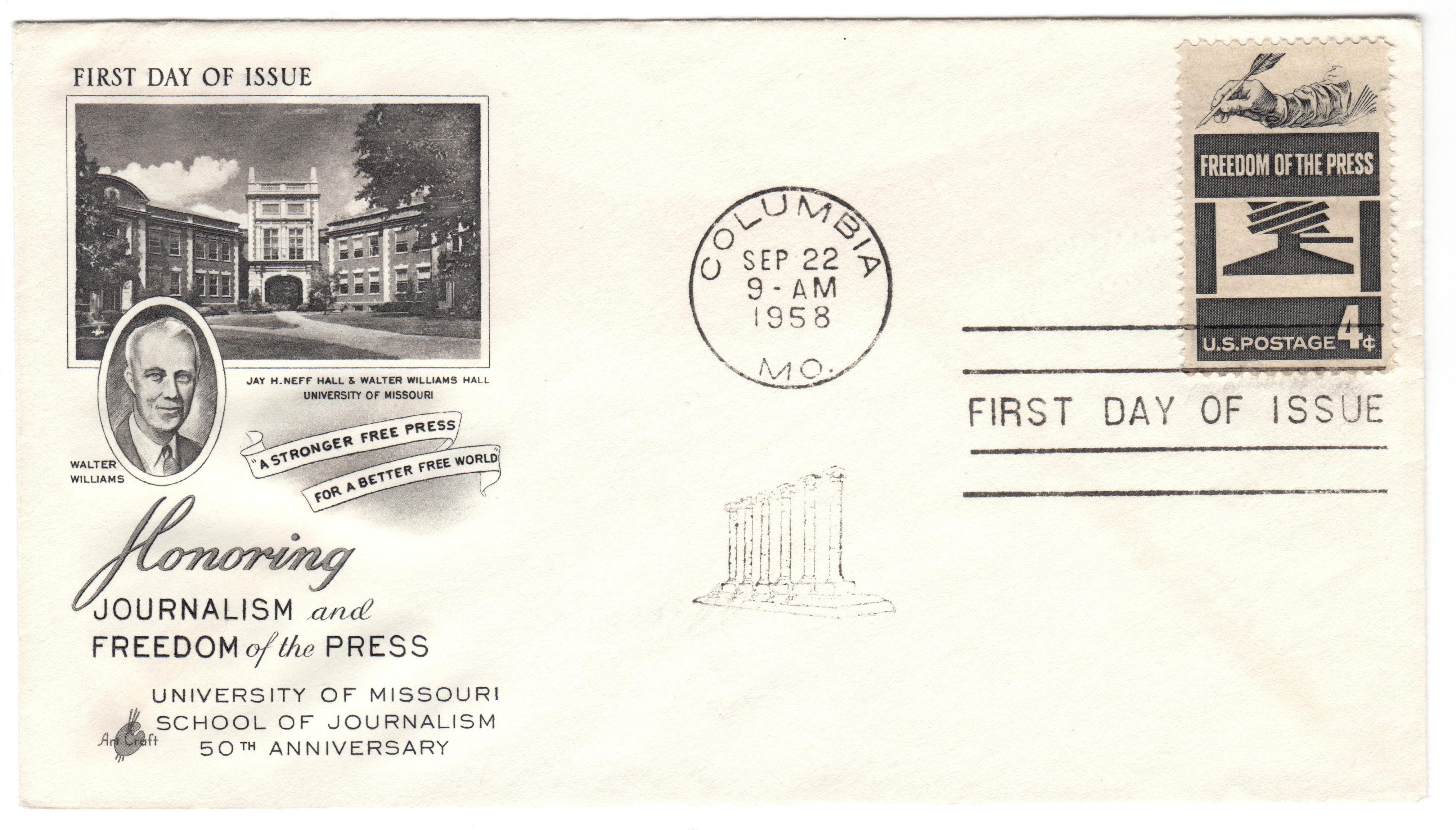
# 4248-52 - 2008 42c American Journalists
American journalists serve as the watchdogs of democracy by keeping the public informed. Our Founding Fathers included Freedom of the Press in the Bill of Rights, as knowledgeable citizens are the key to a successful democratic government. Thomas Jefferson considered the press so important that he once said he would rather have newspapers without government, than government without newspapers.
The early American press was hardly more than propaganda, but over time, this changed. Today, an important part of a journalist's job is offering impartial and truthful coverage of the news. Journalists seek objectivity in their reporting by consulting multiple sources and reporting opposing views. Before a journalist reports the news, he or she first needs to gather the facts, at times risking his or her life to do so.
Martha Gellhorn (1908-98) was one of the world's first female war reporters. She covered the Spanish Civil War, World War II, and the Vietnam War.
John Hersey (1914-93) was a Pulitzer Prize-winning journalist. His book Hiroshima was voted the top work of journalism of the 20th century by New York University.
George Polk (1913-48) was a CBS radio reporter who lost his life reporting on the conflict in Greece following World War II.
Ruben Salazar (1928-70) was a pioneering Mexican-American journalist. He was killed while reporting on Vietnam War protests.
Eric Sevareid (1912-92) was an influential World War II reporter. Following the war, he conducted an award-winning interview with the U.N. Ambassador and went on to be a successful television reporter.
America’s First Journalism School

On September 14, 1908, the University of Missouri School of Journalism became the first such school in the US, and only the second in the world. (The Superior School of Journalism of Paris opened in 1899.)
In the late 1800s and early 1900s, there was significant debate over journalism education. Many people believed that journalism couldn’t be taught in a classroom, rather it had to be learned from an extended apprenticeship. And journalists needed to have a certain talent for the field that they couldn’t simply learn.

In 1895, a bill was submitted to the Missouri State Senate seeking a chair of journalism to be established at the University of Missouri. That bill was rejected, as was the idea of granting the school the ability to give degrees in journalism. The Missouri Press Association backed these ideas again in 1896, but they were again denied.
Walter Williams would be a driving force for change both in Missouri, and the world of journalism. Williams was a dedicated journalist who started his career as a writer for the Boonville Advertiser. In 1889, at the age of 25, he was the youngest president of the Missouri Press Association. By 1908, Williams was editor of the Columbia Missouri Herald and a university curator and pressed for a school of journalism. With the support of Joseph Pulitzer, they finally convinced the Missouri Senate to back their idea. Williams was selected to serve as the school’s first dean.
On September 14, 1908, the University of Missouri School of Journalism officially opened. The first class immediately began work on their first issue of the University Missourian, which later became the Columbia Missourian.

From the start, Williams emphasized a “hands-on” approach to learning, which over time, has become known as the “Missouri Method” of journalism education. Williams stated, “The School of Journalism does not intend to make journalists. It can, however, train for journalism, and this is the purpose of its establishment.” Williams wanted people from around the world to have access to the school’s style of teaching, so they taught journalists from other countries and invited the World Press Congress to the school. He also wrote the Journalist’s Creed (which you can read here).

In May 1910, the school staged its first annual Journalism Week and invited several famous media professionals to lecture throughout the week. In 1930, they awarded the first Missouri Honor Medal for Distinguished Service in Journalism. Since that time, over 500 journalists and organizations have received this award, which is considered one the most prestigious in the industry.
American journalists serve as the watchdogs of democracy by keeping the public informed. Our Founding Fathers included Freedom of the Press in the Bill of Rights, as knowledgeable citizens are the key to a successful democratic government. Thomas Jefferson considered the press so important that he once said he would rather have newspapers without government, than government without newspapers.
The early American press was hardly more than propaganda, but over time, this changed. Today, an important part of a journalist's job is offering impartial and truthful coverage of the news. Journalists seek objectivity in their reporting by consulting multiple sources and reporting opposing views. Before a journalist reports the news, he or she first needs to gather the facts, at times risking his or her life to do so.
Martha Gellhorn (1908-98) was one of the world's first female war reporters. She covered the Spanish Civil War, World War II, and the Vietnam War.
John Hersey (1914-93) was a Pulitzer Prize-winning journalist. His book Hiroshima was voted the top work of journalism of the 20th century by New York University.
George Polk (1913-48) was a CBS radio reporter who lost his life reporting on the conflict in Greece following World War II.
Ruben Salazar (1928-70) was a pioneering Mexican-American journalist. He was killed while reporting on Vietnam War protests.
Eric Sevareid (1912-92) was an influential World War II reporter. Following the war, he conducted an award-winning interview with the U.N. Ambassador and went on to be a successful television reporter.
America’s First Journalism School

On September 14, 1908, the University of Missouri School of Journalism became the first such school in the US, and only the second in the world. (The Superior School of Journalism of Paris opened in 1899.)
In the late 1800s and early 1900s, there was significant debate over journalism education. Many people believed that journalism couldn’t be taught in a classroom, rather it had to be learned from an extended apprenticeship. And journalists needed to have a certain talent for the field that they couldn’t simply learn.

In 1895, a bill was submitted to the Missouri State Senate seeking a chair of journalism to be established at the University of Missouri. That bill was rejected, as was the idea of granting the school the ability to give degrees in journalism. The Missouri Press Association backed these ideas again in 1896, but they were again denied.
Walter Williams would be a driving force for change both in Missouri, and the world of journalism. Williams was a dedicated journalist who started his career as a writer for the Boonville Advertiser. In 1889, at the age of 25, he was the youngest president of the Missouri Press Association. By 1908, Williams was editor of the Columbia Missouri Herald and a university curator and pressed for a school of journalism. With the support of Joseph Pulitzer, they finally convinced the Missouri Senate to back their idea. Williams was selected to serve as the school’s first dean.
On September 14, 1908, the University of Missouri School of Journalism officially opened. The first class immediately began work on their first issue of the University Missourian, which later became the Columbia Missourian.

From the start, Williams emphasized a “hands-on” approach to learning, which over time, has become known as the “Missouri Method” of journalism education. Williams stated, “The School of Journalism does not intend to make journalists. It can, however, train for journalism, and this is the purpose of its establishment.” Williams wanted people from around the world to have access to the school’s style of teaching, so they taught journalists from other countries and invited the World Press Congress to the school. He also wrote the Journalist’s Creed (which you can read here).

In May 1910, the school staged its first annual Journalism Week and invited several famous media professionals to lecture throughout the week. In 1930, they awarded the first Missouri Honor Medal for Distinguished Service in Journalism. Since that time, over 500 journalists and organizations have received this award, which is considered one the most prestigious in the industry.

















